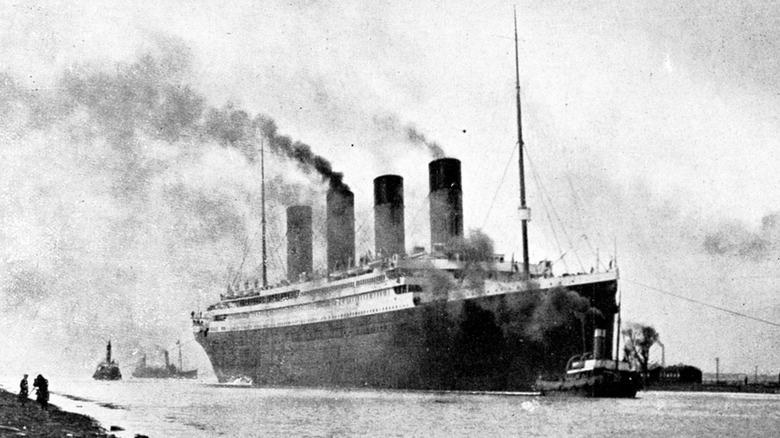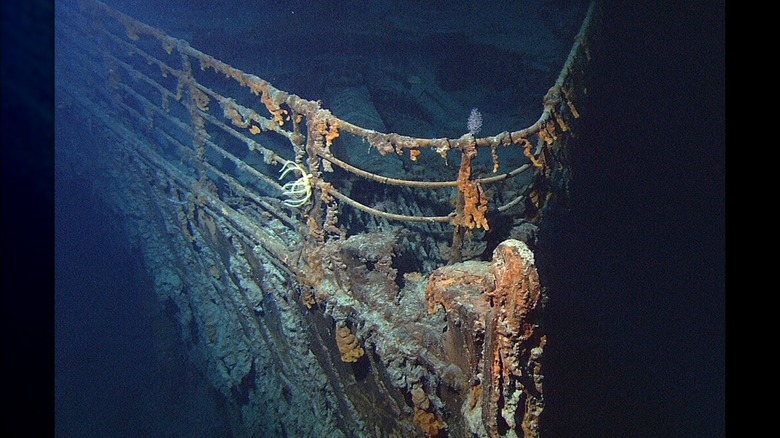Is It Possible To Raise The Titanic?
After hitting the iceberg just before midnight on the night of April 14, 1912, it only took the RMS Titanic a mere two and a half hours to sink below the waves. Over 700 people survived, many of whom later claimed they saw with their own eyes the ship break into two pieces before sinking. However, there was still a prevailing belief — held mainly by those who were never there and didn't experience the tragedy firsthand — that it could somehow be successfully salvaged. Today, that answer is a most resounding no. In fact, not only can it not be raised without utterly destroying it, but it shouldn't even be touched.
Believe it or not, the Titanic wasn't discovered until 1985, mainly because of the location of its remains in the North Atlantic Ocean. The wreckage is 346 nautical miles off the coast of St. John's, Canada, at some 12,500 feet (2.5 miles) below the waves. Once discovered, additional expeditions were made, and it was unequivocally verified that the ship had indeed split into two and sat approximately 2,000 feet apart. What's more, the debris field covered nearly 15 square miles.
Over the last 40 years, some incredible discoveries have been made, including the identification of a bacterium, "Halomonas titanicae," which forms icicle-like structures known as rusticles. Unfortunately, this bacteria has already consumed chunks of the iron structure to the point that any recovery effort would be quite impossible. Sadly, experts believe that many of the Titanic's currently recognizable parts will eventually disintegrate altogether, possibly within our lifetime.
The deep will eventually dissolve its existence
Additionally, the aft section (aka the stern) of the "Royal Mail Steamer" (RMS) Titanic is buried in almost 46 feet of thick, clay-like sediment, which will likely make it impossible to remove. It's not just the fact that the Titanic's structural integrity is simply too fragile to disturb, but over 1,500 passengers lost their lives that night, and it is therefore considered a massive gravesite that many feel should never be disturbed, even though no human remains have ever been found inside the wreckage.
James Cameron brought us the hit film "Titanic" in 1997, and thrust the legendary ship back into the public consciousness. Interestingly, Neil deGrasse Tyson played a part in changing one of the film's scenes. Cameron told The New York Times in an interview in 2012 that during his 33 expeditions down to the site, they never once saw human remains. There are several reasons for that, not the least of which is the numerous deep-sea scavengers doing what they do best. However, another potential theory is that the life preservers, which likely kept many passengers alive for a brief time, ultimately died from hypothermia and were washed away to parts unknown.
But what about bones? According to Robert Ballard, the famed deep-sea voyager and oceanographer who found the Titanic in 1985, once you get below 3,000 feet and enter what's known as the calcium carbonate compensation depth, your bones will eventually just dissolve away, much like the "Halomonas titanicae" bacteria are doing to the iron portions of the great ship.
Ideas to raise the Titanic have been wild
In April 2012, the Titanic was placed under the UNESCO Convention on the Protection of the Underwater Cultural Heritage. In May 2017, the Consolidated Appropriations Act was signed, which made it illegal for anyone to "no person shall conduct any research, exploration, salvage, or other activity that would physically alter or disturb the wreck or wreck site of the RMS Titanic" without first obtaining permission from the Secretary of Commerce.
Before verifying there was no way to raise her, some rather outlandish ideas to do just that had surfaced over the years. Mere weeks after its discovery in 1985, one salvage expert suggested that pumping 180,000 tons of Vaseline (the world-famous petroleum jelly) into polyester bags would harden from the water's cold temperatures. If placed strategically throughout the wreckage, the bags would lift the remains to about 200 feet below the surface, preventing them from dissolving.
Undeterred, another scheme was hatched to place wire mesh around the pieces, pump liquid nitrogen through them, turning them into a "giant iceberg" that would then apparently float to the surface. Yet another suggested a system of hydrogen-filled bags could possibly do the trick. A similar approach suggested using thousands of ping-pong balls to bring her topside; however, those plans were deflated when science explained that they'd all be crushed by the pressure at depth before they could even be put in place. The idea of glass spheres was also floated, but the cost simply would have been far too astronomical ($240 million). Ultimately, it's Mother Nature who will have the last word on the Titanic's future.


